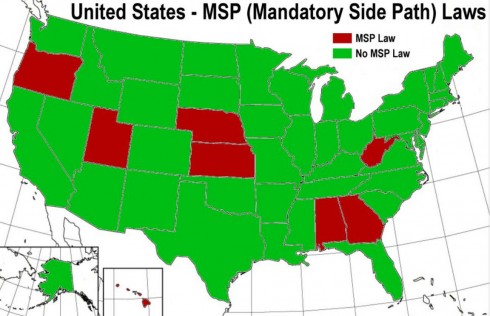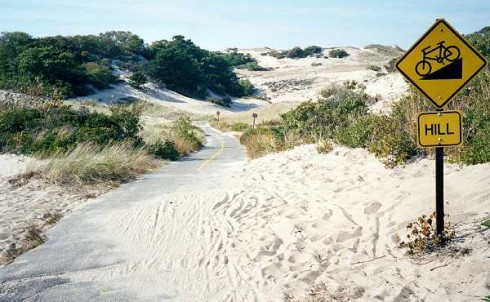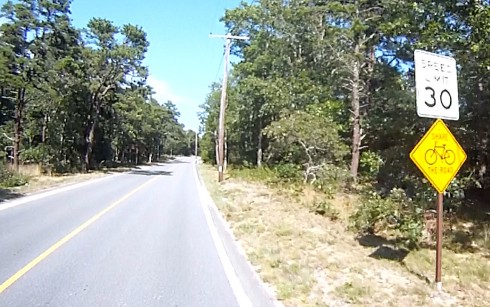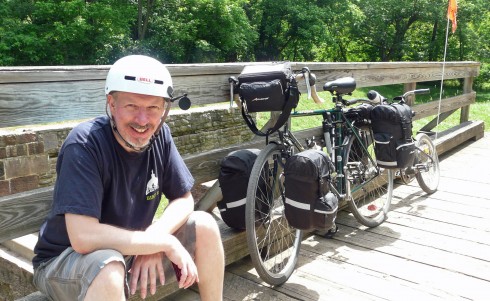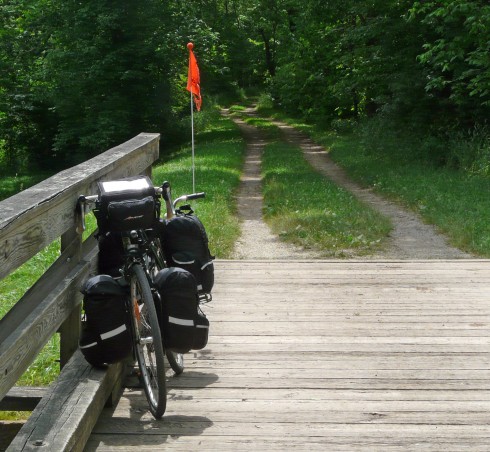Concerning the Austin, Texas bike box report — For background, let me first describe the difference between driver behavior by bicyclists, and so-called edge behavior.
Driver behavior is riding a bicycle according to the ordinary rules of the road for drivers of vehicles. A quick way to describe this is to say that the bicyclist rides like a motorcyclist, but is more often traveling more slowly than other traffic. Like a motorcycle, a bicycle does not occupy the full width of a travel lane. The bicyclist chooses position in a lane depending on travel speed and destination, generally leaving room for other vehicles to pass in the same lane if it is wide enough, but controlling the lane — riding in the middle or toward the left side, if it is too narrow to share. The bicyclist changes lane position by negotiating with other vehicle operators and merging. Like other vehicle operators, the bicyclist merges to an appropriate lane position on approaching an intersection.
In edge behavior, the bicyclist keeps to the right side of the roadway except where special provisions have been made to cross. Edge behavior is similar to what is expected of pedestrians on sidewalks. This is the model which treats bicyclists as being rolling pedestrians instead of vehicle drivers.
Driver behavior makes for smoother and more predictable interaction when bicyclists or other drivers are crossing or turning, but more commonly requires motorists to merge left to overtake, and sometimes to slow and follow a bicyclist until a safe opportunity for overtaking presents itself. Edge behavior, on the other hand, more usually allows motorists to overtake bicyclists without merging or waiting, but encourages motorists to overtake unsafely, and often places motorists and bicyclists in conflict with one another and out of sight of each other when crossing and turning. Edge behavior also leads to conflicts with pedestrians and with opening doors of parked vehicles.
Bike boxes and edge behavior: The most usual kind of bike box, which I call the “inline bike box” attempts to accommodate bicyclists who are riding along the edge of the roadway, typically in a bike lane, and who intend to continue straight ahead or turn left. This is the type of bike box which the Austin report discusses. Bicyclists overtake on the right of motor vehicles stopped at a traffic signal, pass the first waiting motor vehicle on the right, and swerve left in front of it into the bike box to wait for the signal to change to green.
For a detailed description of bike boxes, I direct you to James Mackay’s comments about American bike box installations and my comments about bike boxes in general.
I’ll make comments on some details of the Austin report, and then I’ll make a more general statement.
I think that the report fundamentally misconstrues the intent of bike boxes by describing it as safety improvement. So does the Transportation Research Board announcement, in describing the bike box as a cure for the “right hook” — a motorist’s turning right across the path of a bicyclist. The bike box does nothing to prevent the “right hook” when the traffic signal is green — this video shows why not. Not the bike box, but rather, a prohibition on right turns on red, prevents the “right hook” when the signal is red. Right turn on red must be prohibited in order for bicyclists to enter into the bike box, but it also can exist without a bike box. The bike box poses the risk of other types of collisions, as shown on my Web page previously cited. The bike box probably does reduce the risk of “left cross” collisions — when motorists turn left across the path of bicyclists — by placing bicyclists in view of the left-turning motorists — but bicyclists also can do that for themselves without a bike box, by avoiding overtaking on the right.
The intent of a bike box is not safety. It is to accommodate large volumes of bicyclists when motor traffic backs up at an intersection, and to give bicyclists priority over the motorists. In order to accomplish this, the bike box overturns the fundamental principle of traffic operation of merging to an appropriate lane position before reaching an intersection. In that light, the safety of the bike box is open to question, and any improvements to safety must be evaluated in the context of
- whether the bike box is only legitimizing unsafe and unlawful behavior which occurred previous to its installation,
- whether appropriate and effective education, enforcement and engineering measures are in place to mitigate this problem,
- whether the bike box is creating new problems, and
- whether safety actually increases.
Following are my comments on specific sections of the Austin report:
Executive summary
Here’s the first paragraph of the report:
While Austin has a sizeable network of bicycle lanes, traditional bicycle facilities at intersections are often inadequate and can lead to unsafe interactions between motorists and bicyclists. One potential tool to alleviate this problem is the bicycle box. This device is intended to improve the predictability of bicyclist stopping position at an intersection by allowing bicyclists utilizing a bicycle lane to position themselves in front of motorists waiting at a red light. A bicyclist in this position is more visible to motorists and therefore less likely to be hit by a right-turning motorist. Typically, a “No Right Turn on Red” sign is installed at a bicycle box intersection to further prevent bicyclist-motorist collisions.
The report’s executive summary begins by broadly describing a problem with “traditional bicycle facilities”, without describing specifics, then goes on to state that the bike box may alleviate their problems. I infer this to mean that a bike lane that encourages bicyclists to overtake motorists on the right is unsafe, but bicyclists are more predictable and safer if they overtake motorists on the right and then also swerve across to the left in front of the motorists. Right turn on red must be prohibited, because that is unsafe. Nothing is said about what happens when a bicyclist swerves left just as a motorist is starting up on a new green.
Second paragraph, in part:
Safety was defined along the following lines:
- The bicyclist used the bicycle lane to approach the intersection,
- the bicyclist used the bicycle box after installation,
- motorists did not encroach on the stop line or bicycle box,
- the bicyclist departed the intersection before the motorist and
- the bicyclist did not make an illegal movement, such as running a red light.
My comments:
- Using the bike lane to approach the intersection does not define safety. Resulting crash types (right hook, left cross, bicycle-pedestrian collisions) are well-known. A bike lane may be more or less safe than approaching the intersection outside the bike lane, depending on the design and location of the bike lane, traffic conditions, signal phase and the cyclist’s speed and caution.
- Using the bike box does not define safety. Safety is defined by the crash rate, or lacking data on the crash rate, by potential for conflicts.
- Motorist encroachment does not define (or undefine) safety, though it does indicate a problem with the bike box. Encroachment at different times has different outcomes — for example, encroachment when the traffic signal will remain red prevents entry into the bike box, but if the light is changing to green, it may lead to a collision. The report does not make this distinction.
- The bicyclist’s departing the intersection first does not define safety. Note also that this mentions only one bicyclist and one motorist. If a crowd of bicyclists accumulates in a bike box and then several motorists must overtake later, is this safer than if the bicyclists waited in line with the motor traffic?
- The bicyclist’s making an illegal movement does not define (or undefine) safety, though illegal movements are generally less safe than legal ones. Swerving left in front of a vehicle to use the bike box as intended is, however, an illegal movement, an issue which the report does not address.
Concerning the intersection of Shoal Creek Boulevard and Anderson Lane, discussed in the report, here is the Google overhead view of the intersection, showing the bike box southbound on Shoal Creek Boulevard and no bike lane leaving the intersection. The bike lane approaching the bike box is dashed, so there is a conflict between the premise that bicyclists should approach the intersection in the bike lane, and that motorists preparing to turn right should merge into the bike lane.
Google Maps shows bike lanes exiting the intersection of Speedway and 38th, as indicated later in the report. Cars are encroaching into both bike boxes [as of an earlier version of the satellite view].
This photo also was taken after bike boxes were installed and before they were carpet-painted.
One Google Street View photo [earlier version] shows bicyclists waiting at a traffic light ahead of a bus and properly claiming the lane, but it was taken before the bike box installation.
Background
- References would be useful so it is possible to locate some of the cited studies. Only one of the four references at the end of the document is a bike box study. Other studies, some of which are online and available to the public; are mentioned in the Background section but not cited.
- Also note that this section makes no claim of increased safety based on any of the studies mentioned. There are claims of increased perception of safety and of increased mode share.
Bike Box Detail
The bike box shown is eight feet deep. A bicyclist turning the corner around the right front of a truck with a high hood would not be visible. A typical bicycle is 7 feet long, so there is barely room for a bicyclist to enter the bike box and then steer straight ahead to continue along the street. “No right turn on red” signs were installed, but there is no mention of any of the other safety measures which Mr. Mackay describes (see citation near the start of this review) in connection with European facilities.
Shoal Creek Boulevard at Anderson Lane
The researchers hypothesized that the geometry of this intersection is ideal for a bicycle box because if bicyclists enter the intersection from the bicycle lane rather than from the bicycle box, they will be entering unsafe conditions when they reach the downstream side of the intersection where the lane narrows and a bicycle lane does not exist.
This presumes that bicyclists would otherwise be overtaking motorists on the right and then merging left along the edge of the roadway as it narrows after the intersection — “gutter bunny” behavior. Bicyclists also could merge into line with motorists before reaching the intersection, also avoiding “right hook” conflicts. In any case, the bike box would be usable only when the traffic signal is red. When it is green, bicyclists would either merge before reaching the bike box, or keep to the edge of the roadway over the entire distance. Other treatments which might be more effective here and would work in all signal phases would be a bike lane to the left of a right turn lane (since the road narrows down to one lane south of the intersection anyway) or shared-lane markings. Bicyclist education would help by reducing the amount of “gutter bunny” behavior.
Speedway at 38th
The posted speed limit is 25 mph and the observed hourly traffic volumes ranged from 150 vph to 250 vph in the afternoon.
These very low traffic volumes suggest a bicycle boulevard treatment; however, as Google Street View photos show, this is a bus route. Accommodating a bus route and a bicycle boulevard on the same narrow street could be difficult.
Experimental Design
Phase 2 was the installation of bicycle box markings at each location and videotaping the experimental conditions. The bicycle box at this time will often be referred to as “skeleton bicycle box”. Phase 3 was surveillance of the bicycle box and approaching bicycle lane after it was painted chartreuse with the bordering white lines and all markings kept intact.
The term “skeleton bicycle box” is loaded language, carrying the assumption that carpet painting is preferable.
The five definitions as in the executive summary, measures of behavior and not of safety, are listed here, except that (5) is somewhat different:
(5) the bicyclist does not make an avoidance maneuver or illegal movement.
Avoidance maneuvers, unlike the other definitions listed, do indicate a safety issue. Why not also ask whether motorists made avoidance maneuvers? But also, see the comments about terminology below.
Terminology
This section describes motorist encroachment into a bike lane, however, Texas law states that
To make a right turn at an intersection, an operator shall make both the approach and the turn as closely as practicable to the right-hand curb or edge of the roadway.
Also, the bike lane stripe at Shoal Creek Boulevard and Anderson Lane is dashed, confirming that merging into the bike lane is intended. You can’t both be encouraging merging into the bike lane and at the same time calling it “encroachment.”
Avoidance Maneuver – An avoidance maneuver was recorded whenever a bicyclist rode outside of the lane (e.g. rode on the sidewalk or used a driveway instead of using the bicycle lane).
The researchers are confused in using the expression “avoidance maneuver” to describe taking a different route, using the sidewalk or a driveway. An avoidance maneuver is an abrupt, emergency maneuver to avoid a collision. See for example this video from Consumer Reports magazine.
Results
While only data observed during daylight hours was incorporated into the analysis, it is interesting to note that bicyclists riding at night were observed to stop in the motor vehicle lane significantly more frequently perhaps to increase their visibility to oncoming motorists.
More confused terminology: there is no “motor vehicle lane” — Texas has the standard exceptions to the “keep right” rule, and no mandatory bike lane law. The travel lane is open to all vehicular traffic including bicyclists.
The description of motorist stopping behavior at Shoal Creek and Anderson, with encroachment first decreasing and then increasing again, apparently due to habituation, makes the point that a bike box functions better when there are many bicyclists — it does not “scale down” with small numbers, because it increases motorist inconvenience. As a “set-aside” for a minority group, it breeds disrespect if it is not used.
Figure 8, bicyclist stopping position: note that most bicyclists stopped in the bike lane rather than swerving into the bike box, an effect that was even more pronounced after the carpet painting. The Portland bike box study arrived at the same finding.
With 50% encroachment by motorists at Speedway and 38th, the bike box can hardly be described as successful.
Bicyclist use of the travel lane decreased very substantially, and motorist “encroachment” into the bike lane decreased, to the degree that essentially all bicyclists were now approaching the intersection in the bike lane even when the traffic light was green, risking the right hook. The report does not distinguish between bicyclists arriving on the red and those arriving on the green — useful information, as the two situations are very different.
A bicyclist had the opportunity to access the bicycle box when a motorist did not encroach on the bicycle lane or stop line and there was no additional bicyclist blocking the bicycle box.
And this is the only time bicyclists entering the bike box were counted. Bicyclists waiting in the extension of the bike lane blocked entry to the bike box. This skews the results.
The results of this study show that bicycle boxes accompanied with “No Right Turn on Red” signs can improve the safety of bicyclists and motorists at intersections.
So, which of these measures increased the safety?
In any case, the study did not measure safety and it had only one measure of conflicts. At one intersection, it showed a substantial increase in red-light running by bicyclists, and a 50% rate of encroachment by motorists into the bike box. At Shoal Creek Boulevard, there was a high rate of motorist right turn on red despite the sign prohibiting it and despite the encouragement of bicyclists to overtake on the right.
Conclusions and Recommendations
This section describes a rather long list of problems with the installations, and then recommends that they be duplicated elsewhere. I also find it unfortunate that, as I mentioned earlier, the report does not attempt to compare the installation of bike boxes with alternative treatments. Given the poor performance of the bike boxes, such a comparison is in order. One thing I do agree about is the need for an educational campaign, but on the other hand, education in how to use the bike box is inconsistent with usual traffic skills and traffic law, particularly in the case of bike boxes lacking the safety measures which Mr. Mackay has described.
All in all, this is a weak study which doesn’t produce the data to support its claim of increased safety, and which reveals several serious operational problems with the bike box installations, suggesting to me that another treatment would be preferable. The rates of noncompliance and unlawful actions by both motorists and bicyclists are so high that they would be regarded as indicating failure if the experiment were subjected to an unbiased evaluation.
Taking the discussion to another level —
However, there is another level to the discussion here. With the bike box, government is calling for a fundamental change in the paradigm of behavior by motorists and by bicyclists. Generally, calls for paradigm change come from the public, are spread by civil disobedience, and meet government resistance, sometimes succeeding and sometimes failing. The history of the USA offers many examples, for example, our overthrowing British rule; the ending of slavery; the temperance movement and Prohibition; extension of the right to vote to women and to African-Americans in the South; the recent overturning of the “don’t ask, don’t tell” rule in the military services.
But with the bike box, government is in the unusual position of promoting actions contrary to its own laws. There is further dissonance in that — at the Speedway at 38th installation in any case — many if not most of the bicyclists are students at the same institution which employs the researchers who wrote this report.
The attempt is, then, being made by parts of government to overturn its own laws by promotion of roadway facilities which require unlawful operation, and which regard bicyclists no longer as vehicle operators, but instead as helpless and defenseless — capable only of following a designated route on the roadway, and of obeying traffic signals. Correspondingly, motorists are being asked to look out for bicyclists who are operating in ways contrary to the standard expectations of operation on the roadway according to the traffic law, and in some cases motorists are being asked to perform impossible tasks.
Bicycling advocacy of this type may also be seen as an attempt at a fait accompli, where the laws no longer can function given what has been installed, and as an attempt to build a constituency for a different paradigm by increasing the bicycle mode share.
The students at the University of Texas are young adults. They all are familiar with the rules of the road from riding in motor vehicles, and most hold a driver’s license. On the other hand, without an educational effort, this knowledge does not transfer to their bicycling; typically, college students are either edge riders or don’t believe that bicyclists have to follow the rules of the road. They do not see themselves as drivers. Ironically, though, the students would be a captive audience for any serious attempt by the University to educate them in how to ride their bicycles safely.
The paradigm of bicyclists’ overtaking on the right, and of motorists’ having to look back on their right side before turning right, is deeply ingrained in northern Europe. It has existed since motor vehicles were rare, it is ensconced in law, and it is supported by strict motorist licensing and enforcement. Bike boxes are more recent in Europe, but they are often described as a way to legitimize edge behavior that already occurs with bike lanes: bicyclists’ filtering forward past stopped traffic and overtaking the first motor vehicle waiting at a traffic light. Safety benefits are claimed — in comparison with illegal filtering forward past the stop line when there is no bike box, rather than in comparison with obeying rules of the road for vehicular operation. Bicyclist crash rates in northern European cities are low, but fatal crashes show a predominance of right-hooks in which bicyclists are run over by large trucks, consistent with edge behavior, and with cyclists’ having no concept that they could actively prevent these collisions.
There are historical examples of traffic law paradigm changes. The most dramatic have been the changes from driving on the left to driving on the right in Sweden and Canada. These changes were all undertaken at once, overnight. Changes in law were put in place before those in infrastructure, and bolstered by education campaigns to reach the entire population. What we see instead here is a campaign that chips away at American traffic law and traffic patterns piecemeal, by introducing bits and pieces of European practice in a few places, (only two intersections in Austin), lacking European engineering measures, with no attention to the law and no education campaign, and in a background of motor vehicles’ dominance in the traffic mix. Failure is to be expected.
Aside from this, a paradigm which increases the number of classes of travelers following different sets of rules is bound to increase delay for one class or another, and to promote scofflaw behavior to avoid those delays unless it has achieved nearly universal acceptance. The results of this study show an adverse outcome, particularly as regards motorists’ behavior. Considering bicyclists as victims, so that everyone except themselves is to look out for their safety, is appropriate for children, but it leads to a culture of arrested development by some, and of scofflaw behavior by others who are impatient with living with the inconvenience of children’s rules.
All in all, the Austin study demonstrates failure from an operational standpoint, but it has very little to say about safety, because no actual data on crashes, or even conflicts, was collected. Some data on conflicts might be retrieved from the video data, but data on crashes would require a much larger study.
Other critiques
There is a critique of the Austin report from Austin cyclist Tim Scarry online; also one by Portland, Maine cyclist John Brooking.

 New! Exclusive! Now thanks to ShelBroCo, you can OWN the urban bicycle of your dreams!
New! Exclusive! Now thanks to ShelBroCo, you can OWN the urban bicycle of your dreams! 